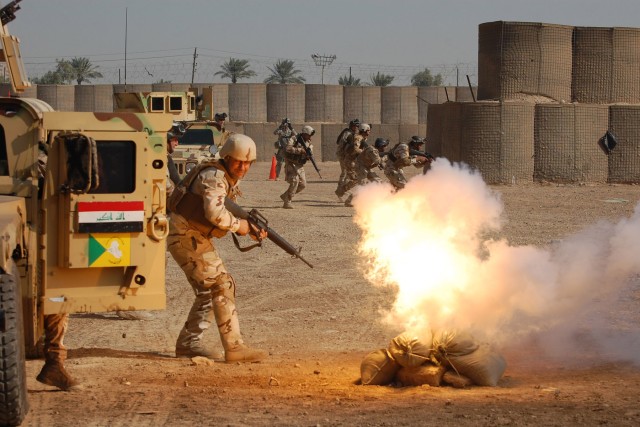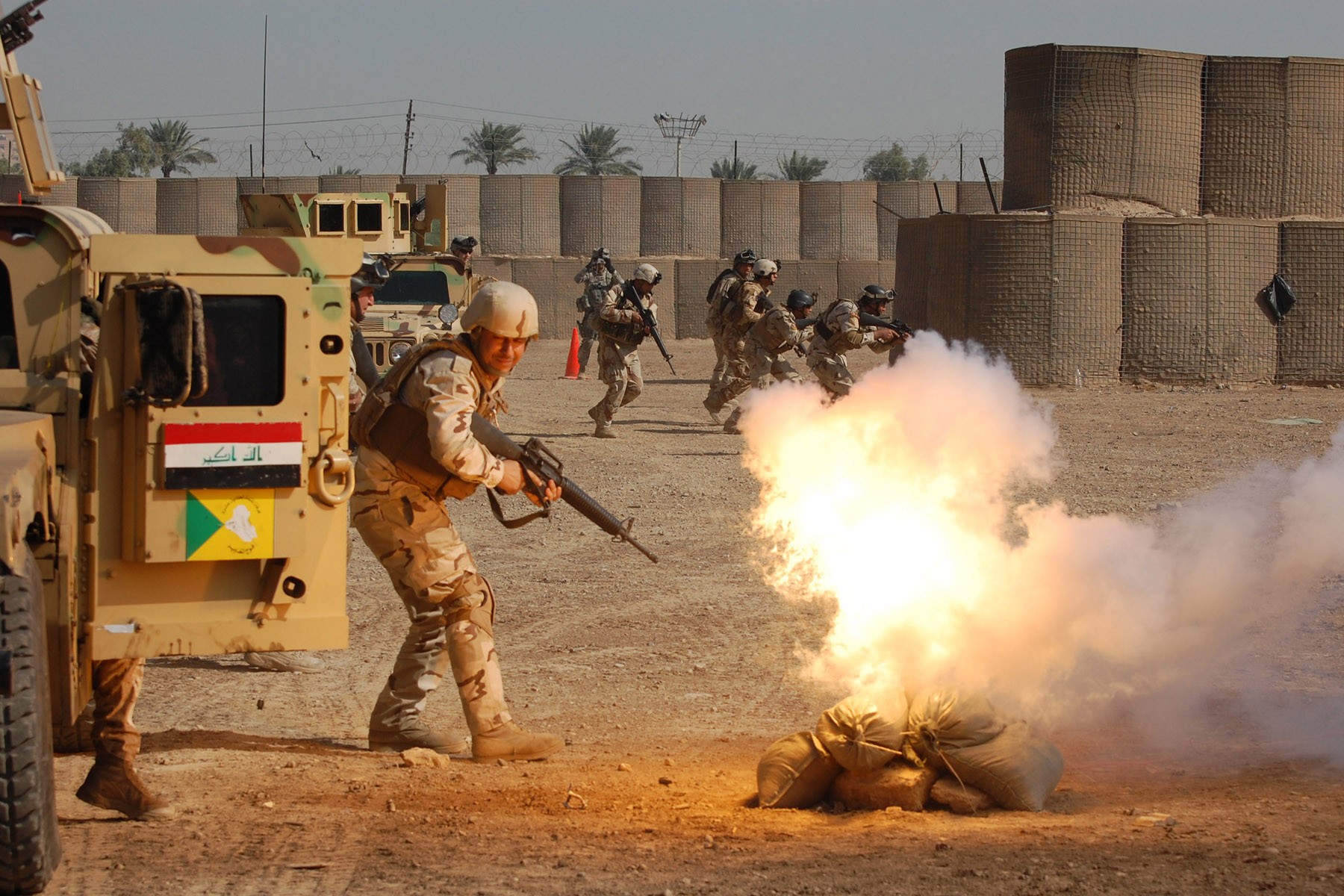
BAGHDAD - The assault on the enemy fighting positions during the live fire exercise began with the explosion of a simulated improvised explosive device (IED).
Iraqi Army soldiers assigned to 3rd Company, Commando Battalion, 11th Iraqi Army Division quickly exited their humvees and conducted 5- and 25-meter checks to ferret out potential IED indicators at the site of the halt. Then, upon receiving notional enemy contact, the squad took up firing positions on line and tactically advanced toward the enemy under the command of 2nd Lt. Muhammed Saadi.
"It's interesting when we come to the range because we can see what they've learned when it comes to (their weapons qualifications) and the tactical movement," Spc. Joel Watkins said. "We can see how well they do (and) from there we can ... correct them and guide them in the right direction."
Specialist Watkins, an infantryman assigned to 2nd platoon, Company B, Task Force 3rd Battalion, 69th Armor Regiment, 1st Advise and Assist Brigade, 3rd Infantry Division, United States Division - Center, and a Moline, Ill. native, is one of several Soldiers who has participated in commando training courses held for the IA at Joint Security Station Old MoD and the Muthanna Range in Baghdad.
For the past six months, 2nd platoon Soldiers have been teaching 11th IAD commandos Soldier skills and tasks in order to help the Soldiers reach a higher level of military proficiency.
Each course has begun with instruction on the basics, including putting equipment together, performing weapons maintenance, zeroing and qualifying weapons, progressing to individual and squad movement techniques, and later to the conduct of dismounted and mounted battle drills.
In addition, the IA soldiers were provided additional training on how to effectively enter and clear rooms as well as how to search detainees and vehicles, along with a live fire exercise that incorporated the Soldier tasks of reacting to contact while mounted, reacting to an IED, and reacting to contact while dismounted topped off each training cycle.
Sergeant First Class Christopher Williams, the platoon sergeant in charge of the training, said the live fire exercise held on the last day of each training cycle was important to the IA-and his Soldiers-for two reasons: "One, it shows that (the IA) are learning and they're actually listening and taking (the) training to heart," Sgt. 1st Class Williams said. "And two, with ... (the U.S. Army) leaving and the breakaway that we're going to eventually get to, it shows that (the IA) have the capabilities they need."
Sergeant First Class Williams, an Albany, Ga., native, said that throughout the training cycle the IA always strove for excellence and enjoyed being provided the opportunities to sharpen skills they had previously learned. He credits the IA Soldiers' dedication to their duty, as well as the hard work of his Soldiers-who overcame the language barrier to provide quality training-for the successes the IA experienced during the commando training courses.
"They (had) fun teaching (the IA)," Sgt. 1st Class Williams said of his Soldiers. "To actually give back and pass on that knowledge to someone a little different ... they (loved) it."
Specialist Daniel Brooks, a China Grove, N.C. native, said his favorite part of the training was teaching the IA basic weapons tasks, such as breaking down the weapons and performing function checks.
"It makes me feel better because at least we're leaving something behind so they can use it, and they can probably learn to adapt it and change it to the ways it works out better for them," Spc. Brooks said.
At the completion of the live fire exercise-leaving the notional enemies neutralized-the IA soldiers rested and talked about their experiences during commando training.
Private First Class Akram Kasem, serving in his third year with the IA, said the most important part of the training was the emphasis the Company B Soldiers placed on the fundamentals of marksmanship.
"The exciting thing and the important thing in this training is when they (taught) me ... how to aim and shoot (and) to take my time," Pfc. Kasem said. "I thank all the Soldiers for the time here with them-we appreciate what (they) are doing."
Private First Class Ahmed Hatim, a four-year IA veteran, agreed with Kasem and said the training was both helpful and exciting because it helped him perfect basic Soldier skills he had learned previously.
"I learned (more about) entering houses, holding detainees and checking (vehicles) at checkpoints," Pfc. Hatim said. "We had a lot of fun, and (we) liked (the training) a lot."
Private First Class Hatim added that the training also brought him and his fellow Soldiers and the American Soldiers closer together as a team.
"Since a long time ago we treat each other like brothers," Pfc. Hatim said. "If one of my friends falls I help him get up (and) if the gunner is tired or sick I take his position-we are brothers."

Social Sharing